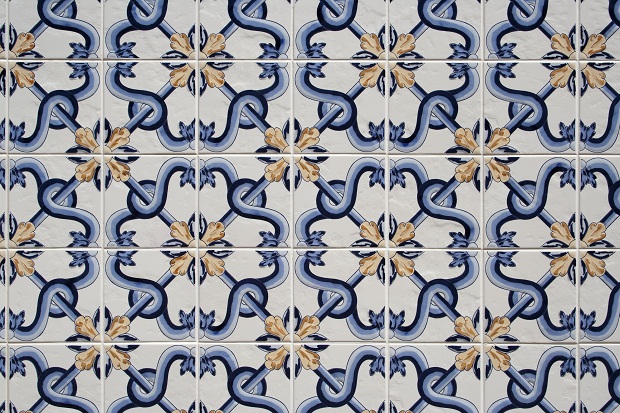Hand-painted antique Azulejo tile art from Portugal represents one of that country’s finest artistic traditions. For more facts & info on ancient Portuguese tile art read on…
The word azulejo (a-zoo-lay-zhosh) literally means “small square tile.” For centuries, Portuguese royalty and spiritual leaders have decorated the inside and outside of their palaces, homes and churches with brilliantly colored antique Portuguese tile art.
In simple terms an azulejo is Portuguese for a square plaque of ceramic material, one side of which is decorated and glazed. Early examples developed from geometric Moorish lace-like and looping designs into European plant and animal themes. These progressed, in turn, from the Gothic to the pure Renaissance style.
Post-Gothic architecture in Portugal produced structures that sported huge, flat areas covered by plaster that were perfectly suitable for further decorations. Hand-painted Portuguese tiles were perfectly suited to fill that need. Color schemes standardized over time as well. By the 17th century blue, yellow, green and white were being supplanted by just plain blue and white.
Developments in the ceramic arts in Italy did not go completely unnoticed in Portugal or the Low countries. Artists in Portugal eventually adopted the majolica technique to paint directly onto tiles. This made it possible to expand compositions to include a variety of figurative themes, historical stories and decorations. Before that happened a group of Italian ceramists moved to the Flanders region, where they disseminated mannerist decorative motifs and the themes of classical antiquity. Once Portuguese orders were placed in Flanders, certain Flemish ceramists relocated to Lisbon, where they initiated the production of tiles in Portugal itself from the second half of the 16th century and after.
In the 17th century it was commonplace to cover large surface areas with tiles. Commissioning large and unique compositions became increasingly untenable financially. This led to repetitive patterns becoming much more common. Checkered designs began to predominate by the end of the 16th and the start of the 17th centuries.
Later on in the 17th century antique Portuguese tile art became much more ornamental. Tile painters began to utilize ornamental engravings from other parts of Europe to create ceramic coverings destined for large wall surfaces. Scaling these engravings up to cover larger surfaces proved challenging. “Grotesques” – secular motifs from ancient Rome also appeared at this time. Possibly appropriated from Rafael’s borrowings from that were used to decorate the Vatican.
Oriental influences mingled with sacred imperatives to produce religiously charged scenes that barely disguised their inspiration from chintz, a type of exotic printed calico originating in India and used as an antependium in front of altars.
Secular scenes depicting war, hunts, legends and comic capers began to appear on tiles as well. Artisans with scant formal training, but highly charged imaginations applied their offerings to large surfaces on buildings or, on a smaller scale, to replace oil paintings.
By the 18th century tile painters regained the status of artists and frequently signed their panels. This era of the masters combined a furious spontaneity with an august attention to the particulars of both human and architectural figures. By mid-century the influence of the French Regency style, and Rococo engravings from central Europe was keenly felt.





